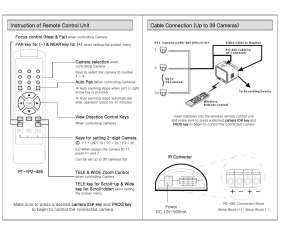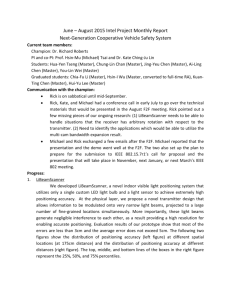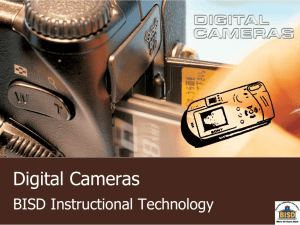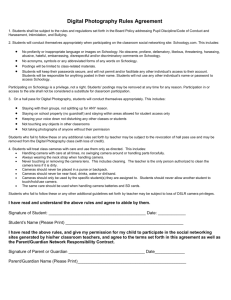Camera_lesson_I_See_What
advertisement
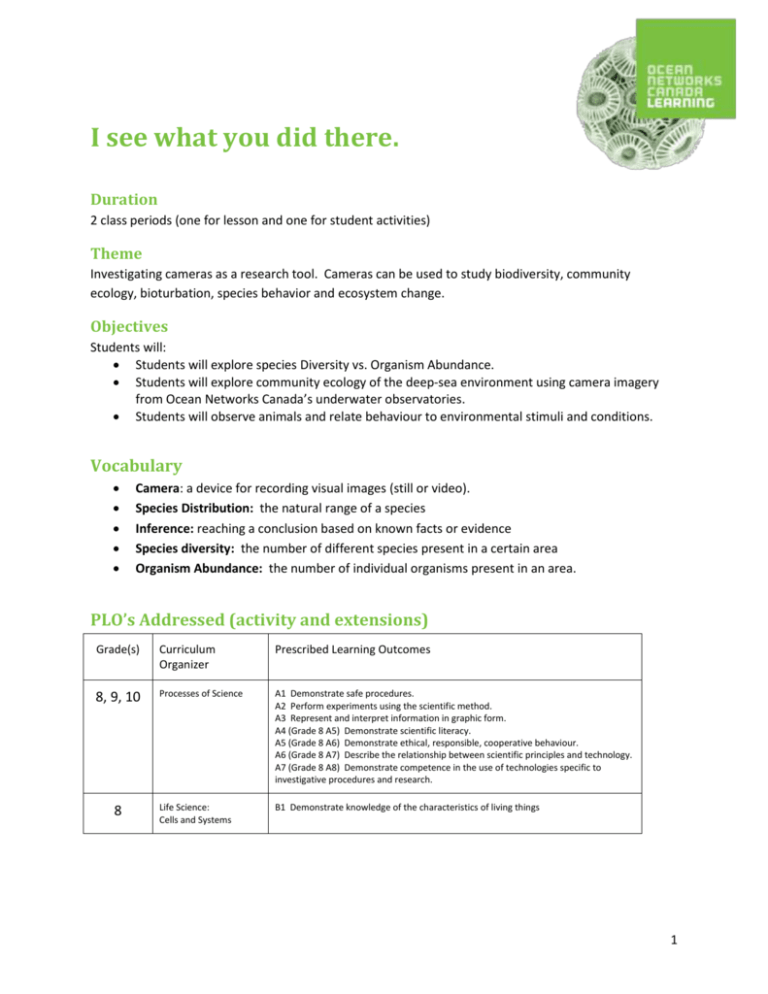
I see what you did there. Duration 2 class periods (one for lesson and one for student activities) Theme Investigating cameras as a research tool. Cameras can be used to study biodiversity, community ecology, bioturbation, species behavior and ecosystem change. Objectives Students will: Students will explore species Diversity vs. Organism Abundance. Students will explore community ecology of the deep-sea environment using camera imagery from Ocean Networks Canada’s underwater observatories. Students will observe animals and relate behaviour to environmental stimuli and conditions. Vocabulary Camera: a device for recording visual images (still or video). Species Distribution: the natural range of a species Inference: reaching a conclusion based on known facts or evidence Species diversity: the number of different species present in a certain area Organism Abundance: the number of individual organisms present in an area. PLO’s Addressed (activity and extensions) Grade(s) Curriculum Organizer Prescribed Learning Outcomes 8, 9, 10 Processes of Science A1 Demonstrate safe procedures. A2 Perform experiments using the scientific method. A3 Represent and interpret information in graphic form. A4 (Grade 8 A5) Demonstrate scientific literacy. A5 (Grade 8 A6) Demonstrate ethical, responsible, cooperative behaviour. A6 (Grade 8 A7) Describe the relationship between scientific principles and technology. A7 (Grade 8 A8) Demonstrate competence in the use of technologies specific to investigative procedures and research. Life Science: Cells and Systems B1 Demonstrate knowledge of the characteristics of living things 8 1 8 10 Earth and Space Science: Water Systems on Earth Life Science: Sustainability of Ecosystems D3 Describe factors that affect productivity and species distribution in aquatic environments B1 Explain the interaction of abiotic and biotic factors within an ecosystem B2 Assess the potential impacts of bioaccumulation B3 Explain various ways in which natural populations are altered or kept in equilibrium Background Camera imagery can be used to monitor underwater experiments or survey environments that are difficult for researchers to access or may be impacted by human interaction. Cameras can also be left in an environment to facilitate long-term study and observations, allowing the researcher to be away from the environment while still conducting a study. Cameras provide a literal glimpse into an environment, allowing researchers to observe animal behaviour, environmental changes, species diversity and organism abundance without impacting these factors with their presence. Further, video and still images preserve a record of organisms and habitat at that moment in time that can be used as a baseline later or to study seasonal changes. As humans are predominately visual animals, cameras can provide us with a lot of information by allowing us to actually ‘see’ what is occurring in an environment. Although temperature, salinity and oxygen data can help us understand a marine environment, cameras allow us to actually observe how these factors impact the organisms that live there. Additionally, cameras allow researchers to compare environments or events that may be interrelated but are a significant distance apart in space or time. For example, cameras may allow researchers to identify species migrations, by recording their presence or absence in particular environments. Although cameras are exceptionally useful tools, they also present some drawbacks to researchers as they can be difficult to maintain and install. Further, cameras only maintain their usefulness as long as the lenses remain in good condition. In shallower locations, cameras can become overgrown by marine life, a process known as biofouling. Equally, if the camera is disturbed or moved, it may alter the researcher’s data set, especially if the data focus is on a specific location or experiment. Finally, researchers need to consider the impact the camera may have on the environment. For example, deepsea environments naturally exist without light and any light the camera set-up emits is essentially a ‘pollutant’ that may impact the organisms that live there. Thus, the lights on most deep sea camera only come on for 2-5 minutes at a time in order to reduce the risk of light pollution. Furthermore, researchers need to consider how lights from the camera system may animal behaviours, and how this may impact their results. Materials 1X large tray/cookie sheet Towel to cover tray 15–20 mixed objects such as: Paperclip Scissors Pens Water bottles Candy 2 Any objects that fit on the tray will do, as the purpose of this activity is to have the students remember as many objects on the tray as they can, the objects themselves have no other purpose. Objects in a theme (e.g. all kitchen tools) will make it easier for students to remember. Still images from Barkley Canyon Pod 1, 2, 3. Access to internet-enabled computers, 1 per student or group. Graphing sheets Procedure Preparation (before students arrive) 1. Lay the objects out on the tray. To make it harder for the students, you can tuck a few objects under or around another, or put them around one another (for example, you could chain paperclips around a water bottle). You may also choose to put objects in relation to one another. For example, you may group black and purple objects together. 2. Cover the tray with the towel to prevent students from seeing it. Optional: Have 2 or 3 different trays ready to complete optional extensions. Activity Explore how cameras allow researchers to observe and record their environment, allowing them to return to the data later or to cross compare from season to season. Further, visually compare species abundance with species richness in an ecosystem. Activity 1 1. Explain to the students, they have been selected to visit a remote and unexplored environment. The environment is quite small and fragile, so they will only get 2 minutes to look at the environment. They can’t take anything into the environment with them, and won’t be able to touch the environment. 2. Gather the students around the tray (the environment) and remove the towel/cover. Give the students 2 minutes to look, but not touch or talk about the environment. 3. After 2 minutes, cover the tray again, and ask the students to write down everything they remember from the environment. Encourage them to make inferences about what they saw. For example, could there be a relationship between objects that are touching? In what way? 4. Have the students discuss what could they learn from only a quick view of this environment? What could have helped them learn more? As a researcher, what tools could have helped them get the most out of their trip to the environment. 5. Explore and discuss, would a camera have been helpful to them? Where do they think they should place a camera so that it would have a minimal impact on the environment and provide the best view? Optional extensions: 3 1. Using a new tray, (or by having students return to the original tray) have the students take one picture on their phone or camera. How does the addition of a picture change their inferences about the relationship among objects? Activity 2 1. Hand out the images from Pod 1, 2, 3. (You may choose to do this activity in groups, rather than individually). 2. Explain to the students, these images are from the Ocean Networks Canada network from cameras that are set at different depths. (Pod 1 = 985 m, Pod 2 =385m, Pod 3 = 891 m). Each image from a particular Pod is from exactly the same time of day, one week apart, beginning June 2. Explain to the students that they will be looking at the images and attempting to answer questions. 3. Ask the students to consider the following questions for all the images: What do you see in this image? Can your images be used to draw any conclusions? (Evidence that particular species live in this area, conclusions about environmental conditions, conclusions about behaviour?) What does this tell you about species diversity or organism abundance? Note: ‘Species diversity’ is the number of different species present, whereas’ organism abundance’ is the total number of individuals present. You may find some areas have low species diversity and high organism abundance or vice versa. How are the different species distributed in the field of view (eg. in single-species or mixed groups, dispersed throughout the image) ? What do the images tell you about environmental conditions at this time (day, season, hour, etc.?) What questions do the images inspire? What more would you like to know about each image? Graphing extensions Have the students graph the number of individuals over the 4 images. Next, have them graph the number of species present. Consider asking: What conclusions can be drawn when the evidence is presented this way? What further information would be needed to support these conclusions fully? In these areas, which is greater, organism abundance or species diversity? Is it the same for both areas? How have diversity and richness changed over a month? Discuss would it be possible to predict what will happen next year or next month? Why might it be difficult to extrapolate based on such a small data set? Are there other, unaccounted for factors that might influence organism abundance or species diversity over the long term? 4 Mini-observatory, all grades 4. Next, explain to the students they will be selecting one day and location to view as a video, rather than as a still image. Before viewing, have the students brainstorm a list of questions they hope to answer by using the video. The images used above have come from these videos. a. Log into Ocean Networks Canada’s SeaTube Pro using the Username and Password provided to you. b. If your page does not immediately display the NEPTUNE Observatory (see name in upper left of page), from the green menu bar at the top, select a NEPTUNE Observatory by clicking on “Tools”, select “Network Preference: […]”, and choose “Switch to NEPTUNE Observatory”. c. Make sure you are operating SeaTube Pro by clicking on “SeaTube” on the green menu bar. d. On the sidebar on the left, click the “+” next to “Barkley Canyon” to expand the menu, and then click the “+” next to the Pod of your choice. Choose “2014”, then “June” and then either the 2, 9, 16, 23 or 30 for the date. Click on “2:00:45” (or as near as possible as this) to view the recording from which the stills were taken. Note: Structures seen in the video are experiments being monitored by different researchers. Your students are encouraged to comment on these structures and to follow their progress in subsequent videos. 5. Discuss, which questions were answered, and which new questions were inspired? How does still (non-moving) footage compare to active (moving) footage? How has the camera contributed to your understanding or curiosity about the deep sea environment? Further Questions Grade 8 How do you know which things in this video are alive? Which characteristics could you observe that lead you to believe something was alive (or not)? Answers may vary depending what is observed. Grade 10 Which factors do you think may have contributed to the location of organisms within the area captured on the camera? Which factors were observable in stills and which were observable in film? In stills and video students may notice the shape of landscape, the direction of the current (as well as food and debris in the current). How do you predict these factors will change over a month or over a year? What evidence would you use to support these conclusions? Predictions may vary. Additional evidence could include more video data and historical data or records. What are the interactions between the biotic and observable abiotic factors in this environment? What inferences can you make about the ecosystem using either still images or live video? 5 Answers may vary, but answers may include animals stirring sediments, biota directing themselves towards the currents to collect food, moving into or out of lights, and or using parts of the environment to survive. Which observable factors might keep populations in check? How might populations change if these factors were altered? Currents may contribute to the number and types of species present. Further, the shape of the landscape may limit the protection available for animals. How does the camera enhance and enable our understanding of the marine environment? Answers may vary. Cameras allow us to actually observe the environment and to make inferences between biological reactions and environmental stimuli. 6




